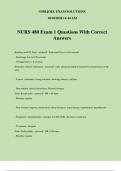©SIRJOEL EXAM SOLUTIONS
10/10/2024 11:44 AM
NURS 480 Exam 1 Questions With Correct
Answers
Reading an ECG Strip - answer✔- Each small box is 0.04 seconds
- Each large box is 0.20 seconds
- 30 large boxes = 6 seconds
Premature Atrial Contraction - answer✔- early electrical impulse initiated by neural tissue in the
atria
- Causes: stimulants, strong emotion, smoking tobacco, caffeine
- Intervention: check electrolytes, lifestyle changes
Sinus Bradycardia - answer✔- HR < 60 bpm
- Rhythm: regular
- Risk Factors: hypoxia, medications (beta-blockers), lyme disease, hypothyroid, hypothermia
- Symptoms: asymptomatic, syncope, low BP, SOB, dizziness, confusion
- Treatment: Atropine
Sinus Tachycardia - answer✔- HR >100 bpm
- Rhythm: regular
, ©SIRJOEL EXAM SOLUTIONS
10/10/2024 11:44 AM
- Risk Factors: anemia, hypoxia, hyperthyroid, drugs
- Symptoms: asymptomatic, SOB, chest pain
- Treatment: beta-blockers (anything ending in -lol), calcium channel blockers (diltiazem,
nifedepine), change in lifestyle
Estimating HR on ECG - answer✔*** RHYTHM MUST BE REGULAR****
- Regular= normal sinus, sinus tachy, sinus brady
- Six Second Method: count number of QRS complexes in a 6 second strip then multiply by 10
- Rule of 300: Find QRS interval hitting exactly a vertical line then go 300 -> 150 -> 100 -> 75
until next interval
- 1500 method: Count large boxes between R-waves until the next wave going 5 -> 10 -> 15-
>..... Then do 1500/x; if you land on a small box count by ones; if you get a decimal, round up
(ex. 1500/19= 78.5 -> 79)
Paroxysmal Supraventricular Tachycardia - answer✔- HR: 150-220 BPM
(doesn't allow heart to contract effectively for perfusion)
-Causes: excess alcohol consumption, stress, caffeine use, overactive thyroid or excessive
thyroid hormone intake, and use of certain drugs
-Sometimes people with anxiety have this, resulting in high BP
, ©SIRJOEL EXAM SOLUTIONS
10/10/2024 11:44 AM
- Interventions: calm then done, Vagal Maneuver; if that does not work give Adenosine
(physician must be present and print recording of EKG with a note of at what point Adenosine
was given; if that does not work, shock them but make sure they are sedated
***PRECAUTION: Adenosine has a half-life of 10 seconds meaning it is fast so it is important
to push it fast in peripheral IV and flush it very quickly right after
Atrial Flutter - answer✔- HR: 250-400 bpm
- Sharp P-waves and numerous p-waves for one QT interval
- Causes: coronary artery disease, right sided heart failure, ischemia, HTN
-Symptoms: palpitations, SOB, dizziness, lightheadedness, fast/steady pulse
- Treatment: internal cardioversion, pacemaker, beta-blocker (esmolol, propanolol), calcium
channel blockers (verapamil, diltiazem)
Atrial Fibrillation - answer✔- HR <100 bpm
-Rhythm: irregular
- Risk Factor: HTN, CVA/TIA, ischemia, age, obesity, ETOH
-Irregular rhythm can cause clots, which is why people are on blood thinners
-Symptoms: palpitations, weakness, fatigue, SOB, dizziness
-Treatment: digoxin, amiodarone, calcium channel blockers, beta-blockers




